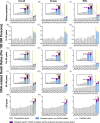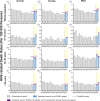Trends in diabetic ketoacidosis- and hyperosmolar hyperglycemic state-related mortality during the COVID-19 pandemic in the United States: A population-based study
- PMID: 39136498
- PMCID: PMC11320749
- DOI: 10.1111/1753-0407.13591
Trends in diabetic ketoacidosis- and hyperosmolar hyperglycemic state-related mortality during the COVID-19 pandemic in the United States: A population-based study
Abstract
Background: During the pandemic, a notable increase in diabetic ketoacidosis (DKA) and hyperosmolar hyperglycemic state (HHS), conditions that warrant emergent management, was reported. We aimed to investigate the trend of DKA- and HHS-related mortality and excess deaths during the pandemic.
Methods: Annual age-standardized mortality rates related to DKA and HHS between 2006 and 2021 were estimated using a nationwide database. Forecast analyses based on prepandemic data were conducted to predict the mortality rates during the pandemic. Excess mortality rates were calculated by comparing the observed versus predicted mortality rates. Subgroup analyses of demographic factors were performed.
Results: There were 71 575 DKA-related deaths and 8618 HHS-related deaths documented during 2006-2021. DKA, which showed a steady increase before the pandemic, demonstrated a pronounced excess mortality during the pandemic (36.91% in 2020 and 46.58% in 2021) with an annual percentage change (APC) of 29.4% (95% CI: 16.0%-44.0%). Although HHS incurred a downward trend during 2006-2019, the excess deaths in 2020 (40.60%) and 2021 (56.64%) were profound. Pediatric decedents exhibited the highest excess mortality. More than half of the excess deaths due to DKA were coronavirus disease 2019 (COVID-19) related (51.3% in 2020 and 63.4% in 2021), whereas only less than a quarter of excess deaths due to HHS were COVID-19 related. A widened racial/ethnic disparity was observed, and females exhibited higher excess mortality than males.
Conclusions: The DKA- and HHS-related excess mortality during the pandemic and relevant disparities emphasize the urgent need for targeted strategies to mitigate the escalated risk in these populations during public health crises.
Keywords: COVID‐19; diabetic ketoacidosis; disparities; excess mortality; forecast model; hyperosmolar hyperglycemic state.
© 2024 The Author(s). Journal of Diabetes published by Ruijin Hospital, Shanghai Jiaotong University School of Medicine and John Wiley & Sons Australia, Ltd.
Conflict of interest statement
Fanpu Ji receives speaker fees from Gilead Sciences, MSD and Ascletis and is a consultant/advisory board member for Gilead, MSD. All other authors do not have any conflict of interest.
Figures



Similar articles
-
Clinical Outcomes in Patients With Isolated or Combined Diabetic Ketoacidosis and Hyperosmolar Hyperglycemic State: A Retrospective, Hospital-Based Cohort Study.Diabetes Care. 2020 Feb;43(2):349-357. doi: 10.2337/dc19-1168. Epub 2019 Nov 8. Diabetes Care. 2020. PMID: 31704689 Free PMC article.
-
Diabetic ketoacidosis and hyperosmolar hyperglycemic state in diabetes patients with heart failure: insight from the National inpatient sample.BMC Cardiovasc Disord. 2025 May 20;25(1):384. doi: 10.1186/s12872-025-04832-3. BMC Cardiovasc Disord. 2025. PMID: 40394470 Free PMC article.
-
Influence of age on the presentation and outcome of acidotic and hyperosmolar diabetic emergencies.Intern Med J. 2002 Aug;32(8):379-85. doi: 10.1046/j.1445-5994.2002.00255.x. Intern Med J. 2002. PMID: 12162394
-
Treatment of Diabetic Ketoacidosis (DKA)/Hyperglycemic Hyperosmolar State (HHS): Novel Advances in the Management of Hyperglycemic Crises (UK Versus USA).Curr Diab Rep. 2017 May;17(5):33. doi: 10.1007/s11892-017-0857-4. Curr Diab Rep. 2017. PMID: 28364357 Free PMC article. Review.
-
Clinical profile and outcomes in COVID-19 patients with diabetic ketoacidosis: A systematic review of literature.Diabetes Metab Syndr. 2020 Nov-Dec;14(6):1563-1569. doi: 10.1016/j.dsx.2020.08.015. Epub 2020 Aug 18. Diabetes Metab Syndr. 2020. PMID: 32853901 Free PMC article.
References
-
- Excess Deaths Associated with COVID‐19. 2023. Accessed March 6, 2023. https://www.cdc.gov/nchs/nvss/vsrr/covid19/excess_deaths.htm
-
- Beliard K, Ebekozien O, Demeterco‐Berggren C, et al. Increased DKA at presentation among newly diagnosed type 1 diabetes patients with or without COVID‐19: data from a multi‐site surveillance registry. J Diabetes. 2020;13:270‐272. - PubMed
MeSH terms
LinkOut - more resources
Full Text Sources
Medical

